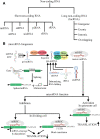microRNAs as neuroregulators, biomarkers and therapeutic agents in neurodegenerative diseases
- PMID: 26608596
- PMCID: PMC11108480
- DOI: 10.1007/s00018-015-2093-x
microRNAs as neuroregulators, biomarkers and therapeutic agents in neurodegenerative diseases
Abstract
The last decade has experienced the emergence of microRNAs as a key molecular tool for the diagnosis and prognosis of human diseases. Although the focus has mostly been on cancer, neurodegenerative diseases present an exciting, yet less explored, platform for microRNA research. Several studies have highlighted the significance of microRNAs in neurogenesis and neurodegeneration, and pre-clinical studies have shown the potential of microRNAs as biomarkers. Despite this, no bona fide microRNAs have been identified as true diagnostic or prognostic biomarkers for neurodegenerative disease. This is mainly due to the lack of precisely defined patient cohorts and the variability within and between individual cohorts. However, the discovery that microRNAs exist as stable molecules at detectable levels in body fluids has opened up new avenues for microRNAs as potential biomarker candidates. Furthermore, technological developments in microRNA biology have contributed to the possible design of microRNA-mediated disease intervention strategies. The combination of these advancements, with the availability of well-defined longitudinal patient cohort, promises to not only assist in developing invaluable diagnostic tools for clinicians, but also to increase our overall understanding of the underlying heterogeneity of neurodegenerative diseases. In this review, we present a comprehensive overview of the existing knowledge of microRNAs in neurodegeneration and provide a perspective of the applicability of microRNAs as a basis for future therapeutic intervention strategies.
Keywords: Biomarker; Body fluid; Neurodegenerative diseases; Therapeutic agent; Tissue-enriched; microRNA; microRNA technological advancements.
Figures


References
Publication types
MeSH terms
Substances
LinkOut - more resources
Full Text Sources
Other Literature Sources
Medical

